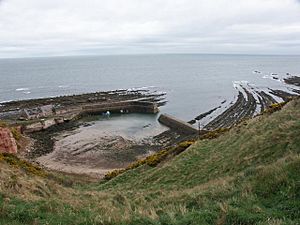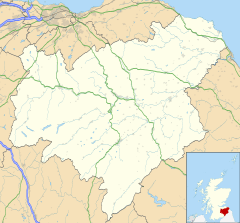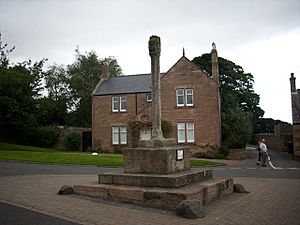Cockburnspath facts for kids
Quick facts for kids Cockburnspath |
|
|---|---|
 Cove harbour |
|
| Population | 411 (2001 census) |
| OS grid reference | NT774710 |
| Council area | |
| Lieutenancy area | |
| Country | Scotland |
| Sovereign state | United Kingdom |
| Post town | COCKBURNSPATH |
| Postcode district | TD13 |
| Dialling code | 01368 |
| Police | Lothian and Borders |
| Fire | Lothian and Borders |
| Ambulance | Scottish |
| EU Parliament | Scotland |
| UK Parliament |
|
| Scottish Parliament | |
Cockburnspath (pronounced KOH-bərnz-path) is a small village in Berwickshire, which is part of the Scottish Borders. It sits close to the North Sea coast. You can find it between the towns of Berwick-upon-Tweed and Dunbar.
Cockburnspath is an important starting or ending point for two long walking trails. It's the eastern end of the Southern Upland Way, a path that crosses southern Scotland. It's also the northern end of the Berwickshire Coastal Path, which follows the beautiful coastline. Nearby, the village of Cove has a small harbour used by fishing boats.
Contents
History of Cockburnspath
The area around Cockburnspath has a very long history. Many archaeological finds show that people have lived and even fought here since the Bronze Age. This area was often on the main route for armies invading Scotland from England.
Long ago, Cockburnspath was known as "Colbrand's Path." This name came from a giant in old stories called Colbrand.
Royal Connections and the Market Cross
In 1503, the lands of Cockburnspath became part of a special gift. They were part of the dowry (a gift given by a bride's family) from James IV of Scotland to Margaret Tudor. Margaret was the daughter of Henry VII of England. Their marriage was called the "Marriage of the Thistle and the Rose." The thistle is a symbol of Scotland, and the rose is a symbol of England.
In the middle of the village, there is a market cross from the 16th century. It has carvings of a thistle on two sides and a rose on the other two. This shows the special connection between Scotland and England from that marriage.
The marriage of James IV and Margaret Tudor was meant to create lasting peace between Scotland and England. They signed the Treaty of Perpetual Peace in 1502. However, this peace did not last long. James IV was killed in the Battle of Flodden Field in 1513. This battle happened just across the border in Northumberland.
Even though the peace was short, this royal marriage was very important. It eventually led to the Union of the Crowns in 1603. This is when James VI of Scotland also became James I of England after Elizabeth I of England died. This meant Scotland and England shared the same king, but they were still separate countries.
Artists and Geologists
In the 1800s, Cockburnspath became a popular place for Scottish artists to visit in the summer. They loved to paint the village, the people working on farms, and the beautiful countryside. Artists like James Guthrie and Edward Arthur Walton even shared a house there in 1883.
Just west of the village is Dunglass. This was the home of a famous geologist named Sir James Hall. In 1788, he went on a boat trip with two other important geologists, John Playfair and James Hutton. They were looking for proof to support Hutton's idea that rock formations were created over incredibly long periods of time, in an endless cycle.
They found amazing examples of this idea, especially at a place called Siccar Point. Sir James Hall even drew a sketch of it. This discovery, known as Hutton's Unconformity, showed layers of rock that were laid down at very different times. It made people realize that Earth's history was much, much older than they thought. Playfair later said that looking at it made his "mind seem to grow giddy by looking so far back into the abyss of time." Hutton's work was very important and influenced later scientists like Charles Lyell and Charles Darwin.
Local Landmarks
The local parish church in Cockburnspath has a unique round tower. There is also the medieval Dunglass Collegiate Church nearby. It's looked after by Historic Scotland and is open for visitors to explore.
Not far from the village is Fast Castle. This old castle was used as a setting in a famous novel by Walter Scott called The Bride of Lammermuir. This book then inspired an opera by Donizetti called Lucia di Lammermuir.
The Lammermuir Hills are an area of high, open moorland that stretches west from the village. In the Middle Ages, these hills were used by nearby abbeys to graze their sheep.
Notable people
- John Broadwood (1732–1812) was born in Cockburnspath. He later became famous for founding Broadwood and Sons, a company that made pianos.




